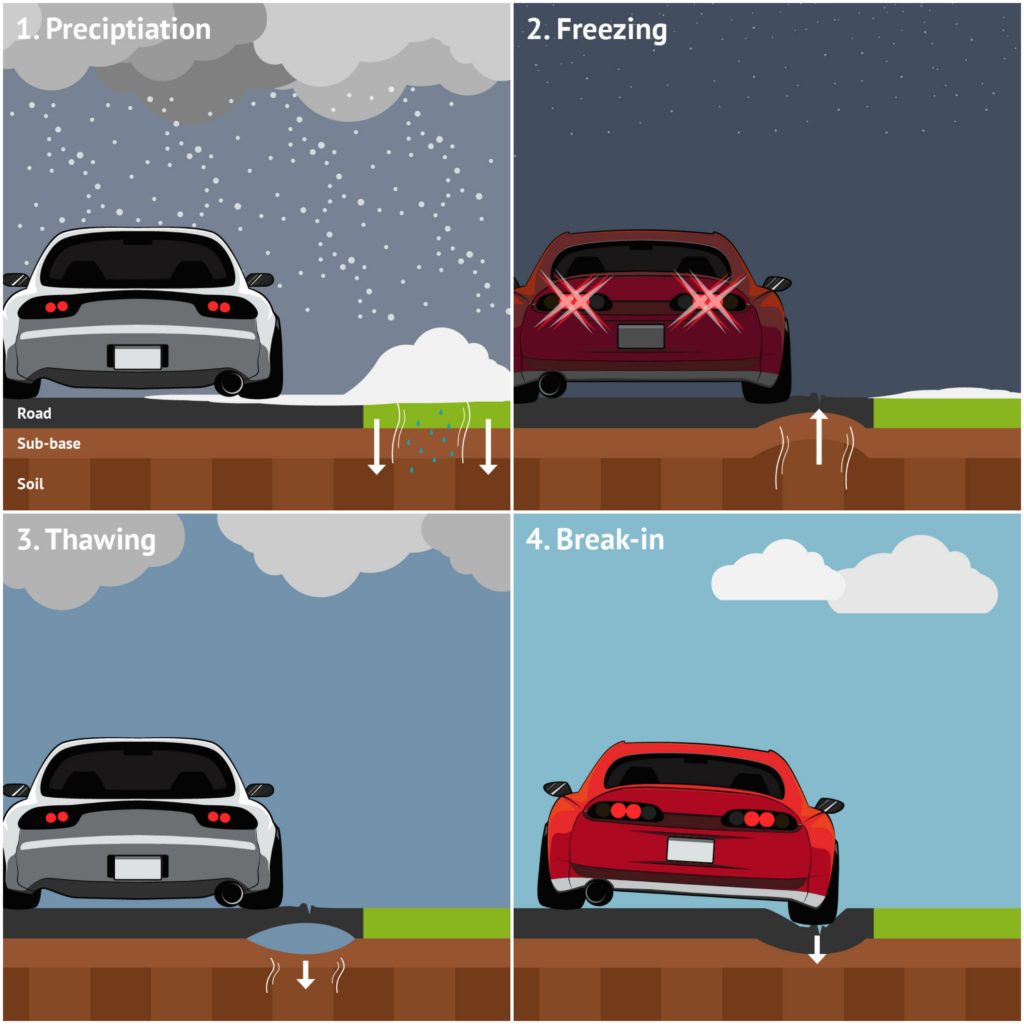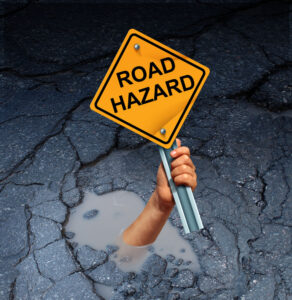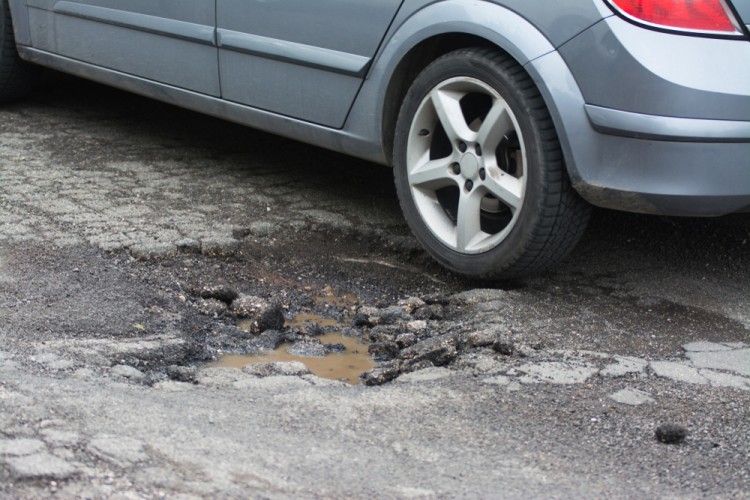Drivers are a diverse bunch. From the dedicated petrol heads to the ones who love a 20mph pootle. Modders, classic car nuts and even, yes, caravan enthusiasts. We all share a love of driving and the open road. But while we may have different loves, there is one thing we all hate…
Potholes.
Every driver hates them. They’re dangerous to your car and other road users. They seem to come out of now here. And apparently, they are invisible to the council.
But how dangerous are they really? What causes them? And most importantly, why, when there has been one outside your house for over a year does no one come along and do anything about it?!
Potholes on the road
An AA survey of 17,000 people has found that 88% of drivers think roads are in a worse state now than 10 years ago. In response to severe weather in March and the growing demand for change, the government promised £6 billion to improve England’s highways.
Despite this, according to the RAC, there has been a 15% increase in breakdowns resulting from damaged road surfaces.
Between April and June 2018, the RAC was called to over 4,000 pothole-related breakdowns. Damage to cars included broken springs, distorted wheels and damaged shock absorbers. These figures don’t even take into account the cosmetic damage caused to bumpers, or minor damage to exhausts that would not require call out.
With the average repair for a pothole costing £1,000, in a year, potholes cost drivers over £10 million in repairs. But it isn’t just motorists who are suffering. In 2017, councils paid out £500,000 more in compensation than the previous year.
These pay outs push up the council’s public liability insurance premiums. The cost of this could be better spent on essential services, investing in the community and even repairing our crumbling roads!
What is a pothole?
A pothole is a defect in the road surface, commonly caused by the weather. As a result, they are most commonly caused during winter and spring, when rain most common in the UK. Due the 14 year repair backlog, potholes can be seen all year round.
How are potholes formed?
In order to stop roads from flooding, most roads are permeable, allowing water to soak through them. But given the right combination of environmental factors, this advantage becomes a liability.
When water soaks through the pavement it enters the soil. In cold weather, the water freezes, causing expansion. This puts stress on the road surface above, causing raised cracks.
When the frozen water thaws and disperses, it leaves behind the cracked surface above and a cavity beneath the road surface of weak soil that was once held together with ice.
When cars (or more commonly, lorries) drive over the affected area, the compromised road surface cannot withstand the pressure of impact and breaks.

The result is a pothole.
Reporting potholes
If you find a pothole on a motorway or an A road, you can report your find to Highways England, who are responsible for maintaining the major roads across the country.
However, the majority of potholes occur on minor roads, which are managed by the council. In this case, you have to report the pothole to the relevant council.
How deep does a pothole have to be to make a claim?
The official depth of a pothole varies from council to council. As a general rule, in order to be considered an “actionable defect”, a pothole needs to be at least 20cm deep.
The reason for this is because the Court is of the opinion that it is unreasonable to expect a council to provide 24hr surveillance of every road it controls and to deploy repairs whenever so much as a scratch appears on the surface.
Through various civil cases, it has thus been determined acceptable to consider only potholes deeper than 20cm as “actionable”.
You can make a claim against the council for a defect of a shallower depth, but it is unlikely to win.
Making a pothole claim against the council
The law that determines whether a local authority is considered liable for damage caused by a pothole is Section 58 Highways Act (1980).
Section 58 outlines the defence the council has to show in order to avoid claims of negligence.
The council need to demonstrate that they had taken reasonable care to ensure that the highway was safe. They need to show:
- that they regularly inspect the highway (twice a year is often enough)
- that they identify any actionable defects and arrange for repair
- that any repairs are sound and undertaken by trained staff
If the council can show that they spotted a pothole 20cm deep, arranged for it to be repaired, but in the meantime you suffered damage to your car, the council has a defence.
If a defect appeared between inspections and was deeper than 20cm and wasn’t reported by the public, the council isn’t liable. They cannot be reasonably expected to repair a defect they were not aware of.
If the council cannot show that they did any inspections over a reasonable length of time, missed the defect and you damaged your car, the defence has failed and the council is liable.
If you damage your car on a defect that is shallower than 20cm, the council is under no obligation to repair it yet, so the council is not considered liable.
Due to the fact that the council only has to demonstrate “reasonable care” in cases of public liability, the bar they have to overcome to demonstrate a defence appears very low.
How low? Over 70% of Highways claims are thrown out before even reaching a court.
How to avoid potholes

Making a claim is extremely hard. So, until the council starts putting that £6bn of government money into repairing the roads, what can motorists do?
1. Slow down
If you hit a pothole at speed, you’re going to do major damage to your car. If you’re driving down unfamiliar roads, stick to the speed limit and keep your eyes open.
2. Stay at a distance
If a car hi s a pothole, the car behind needs time to swerve or suffer the same fate. So keep some distance between yourself and the car in front. This gives you time to swerve. If the car is seriously damaged by the impact, they may make an emergency stop. All the more reason to keep your distance.
3. Prepare for puddles
Potholes, as the name implies, are holes. Holes can fill with water, turning an innocent puddle into a serious hazard. So approach puddles with caution.
If you hit a pothole…
1. Brace yourself
No matter how fast you’re going, driving over a pothole will cause a sudden and violent jolt. A firm grip on the wheel will save you from veering off into traffic and causing even more havoc.
2. Don’t brake
Braking will cause more damage to your car when you hit a pothole. Plus, you might cause an accident involving cars behind you.
3. Maintain decent tire pressure
If your tires are optimally filled, they will do their job and absorb some of the impact caused by hitting a pothole. Overfilled tires can burst, while under filled tires can cause more damage than an impact otherwise might.
Potholes are just one of many reasons why having the right insurance is important. When it comes to premiums and excess, the question of whether to make a claim is always difficult. At Keith Michaels, we’re here to help. We provide a variety of insurance options for car lovers who wish to protect their pride and joy from unexpected damage. Contact us today for a quote.


